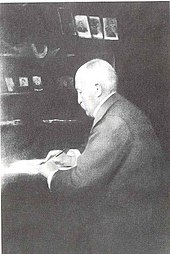Manor house Krummbek
The Krummbek manor is the central structure of the former manor and today's Krummbek manor . Krummbek has been part of the official municipality of Lasbek in the Stormarn district in Schleswig-Holstein since 1974 . The manor is a listed building .
history
In the high Middle Ages, Krummbek was a farming village that originally belonged to Reinfeld Monastery and was possibly created by it. The name is derived from krumm and beke , which means "crooked brook". Krummbek was first mentioned in a document in 1327. After it had fallen desolately, the area became the Meierhof of the noble Gut Schulenburg. As such, he came with Gut Schulenburg in the property of the Marshal of France Count Nicolas von Luckner (1722–1794). He was at the age of 72 years during the reign of terror in Paris under the guillotine beheaded. Gut Schulenburg and the Meierhof were passed on to his son from his estate . In 1803 the Meierhof was separated from the Meierhof Hohenholz by Count Luckner von Schulenburg and sold as an independent noble Krummbek estate. The first owner was Ludwig Carl Christoph Freiherr von Liliencron (1777–1846), who was married to Countess Juliane von Luckner (1788–1863) and fought in the Napoleonic Wars. The marriage came from Rochus von Liliencron . On Krummbek Ludwig von Liliencron experimented with the manufacture of a pure and permanent sugar from the new culture of the sugar beet . The mansion attributed to the architect Christian Frederik Hansen was built under Liliencron .
The property was subsequently owned by Hanseatic merchants, most recently Robert Jauch (1856–1909) from the Jauch family in Hamburg , who sold the property in 1895 for 430,000 gold marks ( around 4.25 million euros) in order to become citizens of Hamburg and to be able to dedicate himself to charitable tasks as a private citizen . His son, who later became Colonel and Freikorps Leader Hans Jauch, grew up on the estate . In 1909 Hermann Lampe acquired the estate, whose heirs still manage it today.
When the manor districts lost their local political independence in 1928, Krummbek was incorporated into the neighboring municipality of Barkhorst. In 1885 Krummbek had 67 inhabitants, in 1925 there were 72 inhabitants.
location
Gut Krummbek 3, 23847 Lasbek
literature
- Hubertus Neuschäffer: Castles and mansions in Südholstein: a manual , 1984
- Deert Lafrenz: manors and manors in Schleswig-Holstein . Published by the State Office for Monument Preservation Schleswig-Holstein, 2015, Michael Imhof Verlag Petersberg, 2nd edition, ISBN 978-3-86568-971-9 , p. 318.
Web links
- Krummbek mansion at www.kreis-stormarn.de
- Gut Schulenburg at www.gemeinde-poelitz.de
- Boundary stone Gut Krummbek to Gut Schulenburg
Individual evidence
- ^ Barbara Günther, Stormarn Lexikon , 2003, p. 209
- ↑ Wolfgang Laur : Historisches Ortsnamelexikon von Schleswig-Holstein , Volume 8 of the Gottorfer Schriften zur Landeskunde Schleswig-Holstein, 1967, p. 136; Antje Schmitz, The names of places and waters in the Ostholstein district , Volume 3 of the Kiel Contributions to the History of German Language, 1981, p. 339
- ↑ Luckner biography ( Memento of the original from July 18, 2011 in the Internet Archive ) Info: The archive link was inserted automatically and has not yet been checked. Please check the original and archive link according to the instructions and then remove this notice.
- ↑ ZSHG , Volume 130, 2005, p. 119.
- ↑ Schleswig-Holsteinischer Heimatbund, Schleswig-Holstein , issues 1–12, 2003, p. 6; Klaus-Joachim Lorenzen-Schmidt, Ortwin Pelc, Schleswig-Holstein Lexikon , 2000, p. 365
- ↑ Henning Oldekop: Topography of the Duchy of Holstein: including the Duchy of Lauenburg District, Principality of Lübeck, Enclaves (8) of the Free and Hanseatic City of Lübeck, Enclaves (4) of the Free and Hanseatic City of Hamburg , 1908, p. 58
- ↑ Hermann Lampe, The Development of the Brunswick Domain Süpplingenburg: A Contribution to Farm Management and the History of German Agriculture , 1910, p. 175
- ↑ Michael Rademacher: German administrative history from the unification of the Reich in 1871 to the reunification in 1990. stormarn.html. (Online material for the dissertation, Osnabrück 2006).
Coordinates: 53 ° 45 ′ 3 ″ N , 10 ° 23 ′ 39 ″ E

